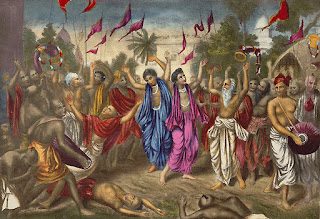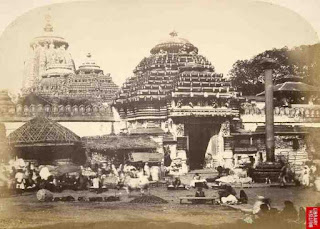 |
| Benefits of Nam sankirtana |
hare krishna hare krishna krishna krishna hare hare
hare rama hare rama rama rama hare hare
iti sodasakam namnam kali-kalmasa-nasanam
natah parataropayah sarva-vedesu drsyate
The sixteen names of the Hare Krishna maha-mantra: hare
krishna hare krishna krishna krishna hare hare, hare rama hare rama rama rama
hare hare destroy all the inauspiciousness of the age of Kali. This is the
conclusion of all the Vedas. (Kali-santarana Upanisad from Krishna Yajur Veda)
sanketyam parihasyam va
stobham helanam eva va
vaikuntha-nama-grahanam
asesagha-haram viduh
One who chants the holy name of the Lord is immediately
freed from the reactions of unlimited sins, even if he chants indirectly [to
indicate something else], jokingly, for musical entertainment, or even
neglectfully. This is accepted by all the learned scholars of the scriptures.
(Srimad-Bhagavatam, 6.2.14)
nama sankirtana deva tarakam brahma drsyate
hare krishna hare krishna krishna krishna hare hare
hare rama hare rama rama rama hare hare
The nama sankirtana(public chanting) of Hare Krishna
maha-mantra delivers a complete revelation of all of spiritual reality.
(Brahmanda Purana 6.59-60)
mukti-hetuka tāraka haya 'rāma-nāma'
'kṛṣṇa-nāma' pāraka hañā kare prema-dāna
"The holy name of Lord Rāma certainly gives liberation,
but the holy name of Kṛṣṇa transports one to the other side of the ocean of
nescience and at last gives one ecstatic love of Kṛṣṇa."
(Chaitanya-charitamrita, Antya-lila 3.257
harir eva samaradhyah sarva deve suresvarah
hari nama maha mantrair nasyatpapa pisacakam
All the grievous sins of one who worships Lord Sri Hari, the
Lord of all lords, and chants the holy name, the maha-mantra, are removed.
(Padma Purana, Svarga Khanda 50.6)
hare krishna hare krishna krishna krishna hare hare
hare rama hare rama rama rama hare hare
sodasaitani namani dvatrimsad varnakani hi
kalau yuge maha-mantrah sammato jivatarane
varjayitva tu namaitad durjanaih parikalpitam
chandobaddham susiddhanta viruddham nabhyaset padam
tarakam brahma-namaitad brahmana gurunadina
kalisantaranadyasu sruti-svadhigatam hareh
praptam sri brahma-sisyena sri naradena dhimata
namaitad-uttamam srauta-paramparyena brahmanah
utsrjyaitan-maha-mantram ye tvanyat kalpitam padam
mahanameti gayanti te sastra-guru langhanah
tattva-virodha-sanprktam tadrsam daurjanam matam
sravatha pariharyam syadatma-hitarthina sada
hare krishna hare krishna krishna krishna hare hare
hare rama hare rama rama rama hare hare
“Hare krishna hare krishna krishna krishna hare hare, hare
rama hare rama rama rama hare hare: This sixteen-name, thirty-two syllable
mantra is the maha-mantra in the age of Kali by which all living beings can be
delivered. One should never abandon chanting this maha-mantra and take to other
so-called purificatory processes which are practiced by rascals, or engage in
chanting other metrical compositions of the name of Krishna that are against
the pure conclusions of the scriptures, or are filled with rasabhasa. About
this divinely spiritual maha-mantra, which delivers one from material
existence, the original guru, Lord Brahma, has said, kali-santararadi srutite, "The
srutis have declared this mantra to be the best means of deliverance in the age
of Kali". Having all heard this from Brahma, the sons and disciples of
Brahma, beginning with Narada, all accepted the Hare Krishna maha-mantra and,
having meditated on it, attained perfection.” (Ananta-samhita)
Ananta-samhita is part of the Narada Pancaratra")
The maha-mantra is further mentioned in Chaitanya
Charitamrita 1.7.83 (krishna-nama maha-mantrera), Chaitanya-charitamrita 3.9.56
('hare krishna, hare krishna' kahe avisrama), Narada Pancaratra, etc.
hare krishna krsneti krsneti mukhyan
mahascarya-namavali-siddha-mantran
krpa-murti-caitanya-deva upagitan
kadabhyasya vrndavane syan krtarth
“When will my heart become satiated by perfecting the
chanting of the Hare Krishna maha-mantra in Sri Vrndavana Dhama, which the most
merciful Sri Caitanyadeva personally chanted and distributed to the fallen
souls out of compassion? This wonderful maha-mantra is mixed with the mellows
of love and is the chief and the perfection of all other mantras. They are full
of spiritual energies and glories.” (Sri Vrindavana Mahimamrta by Srila
Prabodhananda Sarasvati 17.89)
hare krishna rama nama gana dana karinim
soka moha lobha tapa sarva vigna nasinim
pada padma lubdha bhakta vrnda bhakti dayinim
gaura murtim asu naumi nama sutra dharinim
"He makes the gift of the song of the names 'Hare,
Krishna and Rama', and destroys all obstacles such as sorrow, delusion, greed
and suffering. He gives the devotional service of Lord Krishna to the multitude
of devotees who are eager for the shelter of His lotus feet. I fall down
swiftly to offer my prostrated obeisances to the Lord in His golden form, who
holds a string of meditation beads." (Srila Sarvabhauma Bhattacarya,
Susloka-Satakam 23)
sri-radhar bhave ebe gora avatar
hare krishna nam gaura korila pracar
(Vasudev Ghosh's bhajan "Jaya Jagannatha
Sacira-nandana", text 4)
Chaitanya-bhagavata Madhya-khanda 23.75-80: (trans.
Kusakratha Das)
75. The Lord personally taught them, "Please happily
hear from Me the maha-mantra of Lord Krishna's names. It is:
76. Hare Krishna Hare Krishna Krishna Krishna Hare Hare Hare
Rama Hare Rama Rama Rama Hare Hare
77. The Lord said, "Regularly chant japa of this
maha-mantra.
78. In this way you will attain all perfections. Chant at
any time and in any circumstance. There are no other rules for chanting.
79. Gather together, five or ten, in your own homes, clap
hands and sing kirtana of these holy names.
80. You may also sing these words:
haraye namah krishna yadavaya namah gopala govinda rama
sri-madhusudana
('I offer my respectful obeisances unto the Supreme
Personality of Godhead, Krishna. He is the descendant of the Yadu family. Let
me offer my respectful obeisances unto Gopala, Govinda, Rama and Sri
Madhusudana.' Also see Chaitanya-charitamrita 2.26.64)
81. Gathering at home with parents, wife, and children,
please sing kirtana in this way."
japato hari namani sthane sata-gunadhikah
atmanam ca punaty-uccair-japan srotrn-punati ca
"Compared to that person who is attached to chanting
japa, the person who performs loud chanting of the holy name of Sri Hari is one
hundred times better. This is because the person who chants japa purifies
himself, whereas the person who chants the holy name loudly in kirtana purifies
himself, all those who are with him, and everyone else who hear the holy
vibration." (Naradiya Purana, Prahlada-vakya)
pasu-paksi-krma-adi balite na pare
sunile se harinama ta'ra saba tare
japile se krishna-nama apani se tare
ucca-sankirtane para-upakare kare
ata eva ucca kari' kirtana karile
sata-guna phala haya sarva-sastre bole
"The animals, birds, and insects cannot chant the holy
name, but by hearing the holy name chanted they can benefit. Chanting the japa
of the holy name of Krishna purifies oneself, but the loud sankirtana of the
holy name of Krishna benefits all living beings. Therefore, loudly chant the
holy name of Krishna in kirtana, and you will get one hundred times the benefit
of chanting japa. This is the verdict of all the sastras." (
Chaitanya-bhagavata 1.16, Haridasa Thakura speaking)
"Listen my dear Misra, in Kali-yuga there is no need
for severe penances or performance of opulent sacrifices; whoever worships the
Supreme Lord Krishna he be crowned with fortune and success. So go back to your
home and worship Lord Krishna with undeviating faith and attention, giving up
falsehood and pretensions. By chanting the holy name of Lord Hari, Krishna, you
will simultaneously obtain both the proper spiritual practice and the ultimate
goal. In this age of quarrel and hypocrisy the only means of deliverance is
chanting the holy name of the Lord. There is no other way. There is no other
way. There is no other way. I am repeating this great chant for deliverance to
you. This consists of sixteen names of the Supreme Lord with thirty two
syllables: Hare Krishna Hare Krishna Krishna Krishna Hare Hare Hare Rama Hare
Rama Rama Rama Hare Hare. By constantly chanting and worshiping this Maha
Mantra, your heart will feel the first blossoming of love and God; then
gradually you will understand the truth about the proper spiritual path and the
ultimate spiritual goal." ( Chaitanya-bhagavata 1.14, Lord Caitanya
Mahaprabhu speaking to Tapana Misra)
In his purport to Caitanya-bhagavata Bhaktisiddhanta
Sarasvati says very clearly that Haridasa Thakura chanted either loudly or
softly and that is why his cave became Vaikuntha.
Chaitanya-bhagavata 1.16.172:
tabe haridasa ganga-tire gopha kari'
thakena virale ahar-nisa krishna smari'
"Then Haridasa went and found a cave on the bank of the
Ganges. He remembered Krishna day and night as he resided alone in the
cave."
Purport: "While remaining in a solitary cave on the
bank of the Ganges at Phuliya, Srila Thakura Mahasaya loudly chanted the names
of Krishna and passed his days and night remembering the pastimes of the Lord.
Sometimes he would chant the sixteen name, thirty-two syllable, maha-mantra
loudly (uccaihsvare), and sometimes he would chant softly (mrdusvare). Every
day he would complete the chanting of three hundred thousand holy names, or in
a year he would chant one hundred million names of Hari. Some people consider
that chanting the names of Krishna in a solitary place is in the category of
"upamsu-japa," or "chanting very mildly." They say that
this maha-mantra, or chanting the holy names of the Lord, should not be heard
by others; only the person who is chanting should hear. If the lips move, or if
the holy names are recited, then they will automatically be heard by others.
But if such persons lack faith in the Vaisnavas who chant the holy names of the
Lord, then by the influence of Kali they dare to quarrel with those Vaisnava
chanters."









